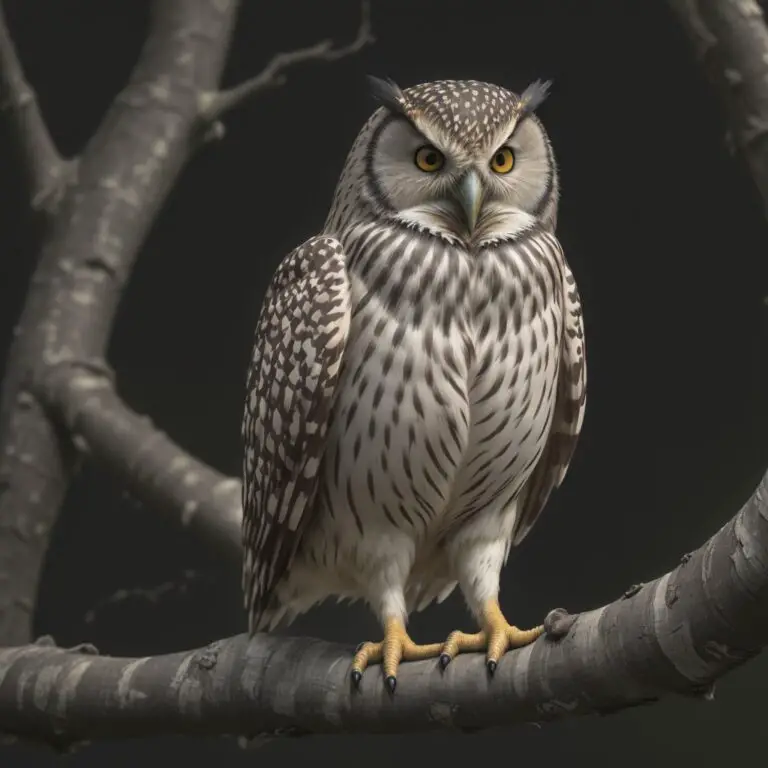Introduction
Owls have always captured the fascination of humans with their mysterious nocturnal habits and silent flight. Among their many remarkable features, their legs stand out as an engineering marvel, playing a crucial role in their ability to hunt with stealth and precision.
Understanding Owl Anatomy
Owls are equipped with specialized physical attributes that make them efficient predators. While their distinctive facial discs and keen eyesight often steal the spotlight, their legs are equally fascinating. These legs, though seemingly unremarkable at first glance, possess unique adaptations that contribute to their silent flight and deadly hunting prowess.
Evolutionary Adaptations
Over millions of years, owls have evolved to become masters of the night. Their legs have undergone significant adaptations to suit their predatory lifestyle. From changes in bone structure to the arrangement of muscles, every aspect of their legs has been finely tuned by evolution to meet the demands of their environment.
Mechanics of Silent Flight
Silent flight is a remarkable feat achieved by few bird species, and owls are among the elite. Unlike other birds whose wing flaps produce audible sounds, owls glide through the air with an almost eerie silence. This feat is partly attributed to the unique design of their wings, but their legs also play a crucial role in minimizing noise during flight.
Unique Characteristics of Owl Legs
Owl legs possess several unique characteristics that contribute to their exceptional hunting abilities. One key feature is their feathered legs, which aid in noise reduction and provide insulation during cold nights. Additionally, their long and powerful talons enable them to grasp prey securely, while their flexible joints allow for precise movements during the hunt.
Feathers and Flight
Feathers are not only essential for flight but also play a vital role in sound reduction. Owl legs are densely covered in feathers, which disrupt airflow and minimize turbulence, further enhancing their silent flight capabilities. This intricate combination of feathers and specialized leg structure enables owls to move through the night sky undetected by their prey.
Musculoskeletal System
The musculoskeletal system of owls is finely tuned for efficiency and precision. Their leg muscles are incredibly strong, allowing them to exert powerful forces when capturing prey. Furthermore, their bones are lightweight yet sturdy, providing the necessary support for their aerial acrobatics.
Hunting Strategies
Owls employ a variety of hunting strategies, all of which are facilitated by their unique leg anatomy. From perching silently in wait to swooping down on unsuspecting prey, every aspect of their hunting behavior is finely tuned to maximize success. Their legs play a central role in these strategies, allowing them to execute swift and decisive attacks with minimal noise.
Comparative Anatomy
Compared to other bird species, owl legs exhibit several distinct differences that set them apart as specialized predators. Unlike birds of prey with sharp, hooked talons, owls have elongated talons ideal for gripping and immobilizing prey. Additionally, their flexible joints give them unparalleled agility in flight, enabling them to navigate through dense forests with ease.
Biomechanics of Owl Legs
The biomechanics of owl legs are a subject of ongoing research and fascination. Scientists study the intricate movements and structures of owl legs to uncover the secrets behind their silent flight. By understanding the biomechanics involved, researchers hope to gain insights that could inspire new innovations in aerospace engineering and robotics.
Research and Studies
Numerous studies have been conducted to unravel the mysteries of owl legs. From anatomical dissections to biomechanical simulations, scientists have employed various techniques to gain a deeper understanding of these remarkable appendages. Each study brings us closer to unlocking the full potential of owl leg adaptations.
Technological Applications
The knowledge gained from studying owl legs has the potential to revolutionize various fields, including aviation, acoustics, and robotics. Engineers are exploring ways to mimic the silent flight capabilities of owls to design quieter aircraft and drones. Additionally, the flexible joints and powerful talons of owl legs serve as inspiration for the development of robotic manipulators capable of delicate and precise movements.
Conservation Implications
Understanding owl leg adaptations is not only crucial for technological advancements but also for conservation efforts. Owls play a vital role in maintaining ecosystem balance by controlling rodent populations. By preserving their habitats and ensuring their survival, we can protect biodiversity and safeguard the delicate balance of nature.
Future Directions
As technology advances and our understanding of owl legs deepens, new avenues of research will continue to emerge. From exploring the genetic basis of leg adaptations to developing innovative conservation strategies, the future holds endless possibilities. By continuing to unravel the mysteries of owl legs, we can gain valuable insights into the wonders of evolution and the intricacies of the natural world.
Conclusion
Owl legs are a testament to the ingenuity of evolution. Through millions of years of adaptation and refinement, these remarkable appendages have enabled owls to thrive in diverse environments and master the art of silent flight. By studying owl legs, we gain not only a deeper appreciation for the wonders of nature but also valuable insights that can inspire technological innovation and inform conservation efforts.
FAQs
1. Are owl legs really feathered?
- Yes, owl legs are covered in feathers, which help reduce noise during flight and provide insulation in cold weather.
2. How do owl legs contribute to silent flight?
- Owl legs play a crucial role in silent flight by minimizing turbulence and disrupting airflow, allowing owls to move through the air with minimal noise.
3. Can owl leg research benefit other fields?
- Yes, the knowledge gained from studying owl legs has applications in aviation, robotics, and acoustics, among others.
4. Why are owl legs important for conservation?
- Owl legs are essential for hunting and maintaining ecosystem balance by controlling rodent populations. Preserving owl habitats is crucial for biodiversity conservation.
5. What are some future research directions for owl legs?
- Future research on owl legs could explore genetic adaptations, biomechanical principles, and their implications for technology and conservation.


